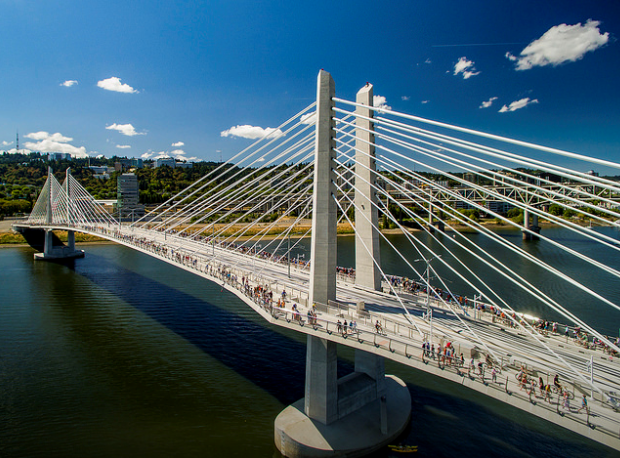While there will be no impact to transit riders, cyclists and others should plan for minor detours October 9–27
TriMet’s singularly iconic bridge and jewel of the Willamette River will soon undergo its first intensive examination of its cable system this month, a critical component in supporting the “cable-stayed” bridge. To accommodate the work, Tilikum Crossing, Bridge of the People, will have intermittent closures of the north and south multi-use paths from Oct. 9 through Oct. 27.
The bike and pedestrian paths on both sides of the bridge will undergo alternating closures, always with one side open. For the safety of pedestrians and cyclists alike, bikes and e-scooters should not be ridden against the flow of traffic. Instead, they will be detoured to the nearby Hawthorne Bridge. Cyclists can also choose to walk their bikes across the bridge. Pedestrians will be able to cross using the open path. There will also be signs posted notifying people of the closed paths. There will be no impact to bus, MAX or Portland Streetcar service over the bridge.
The three-week project allows for the first in-depth inspection of Tilikum Crossing’s cable system. Inspectors will be looking for defects that go above and beyond simple wear and tear. To perform the work, they will need to use boom lifts and mobile elevated work platforms to get under, to the side of and above the bridge deck.
As the inspection may lead to minor adjustments for those on foot, bike or scooter, TriMet reminds them to continue using the marked crosswalks. They are located near the South Waterfront/SW Moody MAX Station on the west end or the OMSI/SE Water MAX Station on the east end of the bridge. We appreciate people’s patience as we perform this important work.
Maintaining the Bridge of the People
With cables radiating out of two towers and connecting at the deck, they function as supports for the bridge’s substructure, which spans 1,700 feet. The towers resist the tension in the cables and transfer the loads to the foundation. But this means that the cables and other bridge components, like the cable anchors, should be inspected over time to make sure they’re working properly.
October’s inspection will be the first to look solely at the cable system. After this, inspections of the cable system will take place every four years. They come in addition to the general inspections we conduct every two years in accordance with the Federal Highway Administration, the most recent of which happened in June.
The manufacturer, French engineering firm Freyssinet, will be performing the inspection with the assistance of TriMet’s Maintenance of Way team. This initial inspection is notable, as the Tilikum Crossing is the first bridge in the U.S. to use Freyssinet’s multi-tube saddle design for the cable system—making Tilikum Crossing unique to the U.S. not simply for being car free but also for its engineering. The special design allows each cable to run continuously from the deck, through the top of the tower and back down to the other side.
Inspections increase longevity
Inspections like this help us keep Tilikum Crossing safe. Opening in 2015 as part of the Portland-Milwaukie Light Rail Transit project, the bridge was constructed to last at least 100 years with regular upkeep. That’s why general safety inspections are required on Tilikum Crossing and the adjacent Harbor Way structure every two years. Since the bridge opened in 2015, these inspections have taken place in June 2023, 2021, 2019 and 2017. Learn more about Tilikum Crossing.








